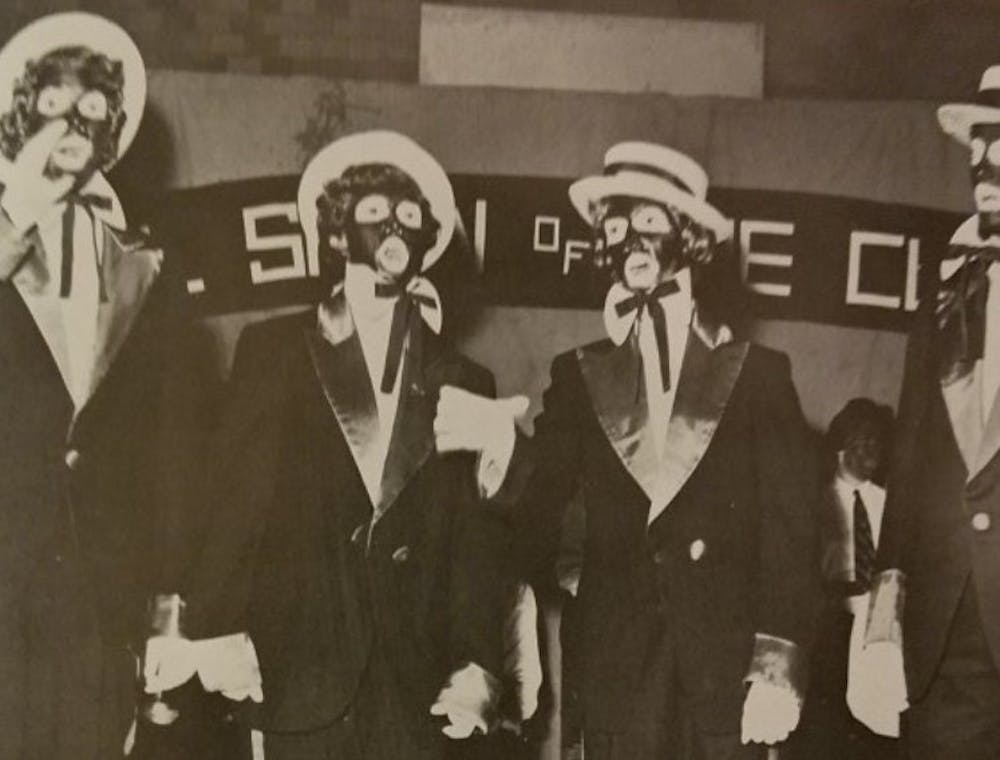The doors to the Lora Robins Gallery stood wide open as visitors were ushered into a room filled with row after row of glass shelves. Intricate stones and dazzling gems lay on the glass, bathed under fluorescent lights that shone from above. Straight ahead rested three tables fixed in a square shape and bending under the weight of what lay on top: piles of documents, battered yearbooks and photographs in black and white.
Behind it all stood senior Dominique Harrington, with members of the 50th anniversary committee – a student-led organization founded and headed by Harrington dedicated to celebrating half a century of racial integration on campus.
Yet Harrington did not create the committee solely to celebrate racial integration. She formed it to educate the campus community about UR’s past with race and racism as well.
In collaboration with the Race & Racism at the University of Richmond Project and the gallery, the 50th committee hosted its first event, titled “Our History Untold,” and invited members of the community to see data collected from the archives that showcased some of the university’s problematic past.
“The foundations of the university seem to be along the dominant narrative of inevitable progress, but that’s not the case,” Harrington said. “Integration didn’t happen due to circumstance and it didn’t happen just because it was bound to happen. There were a variety of internal and external pressures that forced the university to finally allow black students to come [here].”
UR would not racially integrate until 1968, when Barry Greene, Isabelle Thomas, Madieth Malone and Josephine Ethel Otey became the university’s first black students on the main campus.
“1975,” Harrington said, as she pointed to a picture in one of the yearbooks. “We have black students coming together and forming their own space on campus. But then we have the picture there, 1980, where white students in Greek life are using blackface. We still have some of the same issues today that we had back then, so acknowledging this history and having conversations about it will lead us to a better future."
The history of blackface can be traced to the 19th century during the rise of minstrel shows. In these shows, white actors would use black grease paint to portray a caricature of a black person. These portrayals were offensive and perpetuated harmful stereotypes that sustained white supremacist ideology in mainstream American culture.
Blackface, alongside redface and yellowface, has led to national conversations about cultural appropriation and racism. This national conversation made its way to UR when in 2015, a UR student government senator resigned after facing backlash for dressing up as a “Native American” in redface for a dance social.
Although blackface, redface or other racial caricatures may have been somewhat rare occasions in recent UR history, students -- such as senior Christopher Rein -- said they were shocked by how often these racist actions were practiced in the past.
“There’s people from the 1920s dressed up in [Ku Klux Klan] uniforms in our yearbooks and we just casually put that in there,” Rein said. “I think it’s kind of curious to reflect on it now and how does this legacy still affect us.”
As an example of how UR’s past has influenced its present, Rein mentioned a 2018 Princeton Review article that was on display at the event.
Enjoy what you're reading?
Signup for our newsletter
Titled “Little Race/Class Interaction,” the article ranked UR as the ninth worst school on the basis of “how strongly students agree that different types of students (black/white, rich/poor), interact frequently and easily at their schools.”
It was last year when Harrington decided to create the 50th anniversary committee. She and fellow members of the Race & Racism Project were invited to the College of William and Mary to present their research findings for William and Mary’s own 50th anniversary of racial integration.
“After the presentation, Dom [Harrington] said to me, ‘Hey why is this not happening here? Barry Greene started in the fall of 1968. It’s been 50 years. We need to do something,’” said Irina Rogova, the project archivist of the Race & Racism Project. “So I said [to Harrington], ‘Great. What are we going to do?’”
From then on, Harrington would spend countless hours over the summer mobilizing students in preparation for a year’s worth of events. Although Harrington said figuring out the logistics for these events had been difficult, another problem became apparent: funding, or the lack thereof.
“The main challenge that the committee has had from the beginning is being a student-led effort,” Rogova said. “That doesn’t often come with a lot of money or budgeting to get events done. Some more funding and support would be excellent for what the students are looking to do.”
Nevertheless, Harrington was determined to achieve her goals for the 50th anniversary committee.
“It’s important to highlight the history of the university,” Harrington said. “Unless we confront how the university got to be what it is today, then we can’t imagine a realistic, holistic and inclusive future for everybody.”
Contact senior news writer Joshua Kim at joshua.kim@richmond.edu.
Support independent student media
You can make a tax-deductible donation by clicking the button below, which takes you to our secure PayPal account. The page is set up to receive contributions in whatever amount you designate. We look forward to using the money we raise to further our mission of providing honest and accurate information to students, faculty, staff, alumni and others in the general public.
Donate Now



